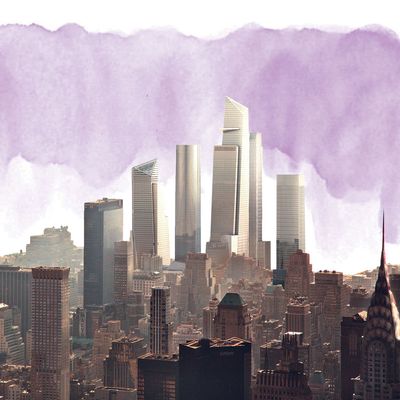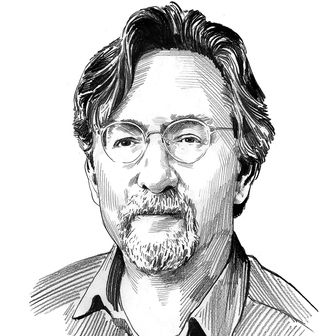
When you’re putting up a multibillion-dollar tower that’s a quarter-mile high, there’s not much leeway to make it a work of art. On the other hand, when you’re putting up a multibillion-dollar tower that’s a quarter-mile high, it had damn well better be a work of art. Dozens of supertall buildings are being built or planned, radically redrawing the skyline. If we avert our gaze, we’ll get a bundle of glass stakes fencing off the air above Manhattan. Skyscrapers can be better. The difficulty of making an elegant symbolic presence out of an immense vertical machine has been vexing architects for more than a century. And yet it must be done.
“Problem,” declared the skyscraper wizard Louis Sullivan in 1896: “How shall we impart to this sterile pile, this crude, harsh, brutal agglomeration, this stark, staring exclamation of eternal strife, the graciousness of those higher forms of sensibility and culture that rest on the lower and fiercer passions?” Sullivan knew from experience that in big buildings, aesthetics struggle to assert themselves against the overweening realities of technology, zoning, and real-estate arithmetic. But he also saw that unless the tower could be ennobled, it would do violence to urban life. That remains true, especially now that some spires reach ten times higher than he ever contemplated.
Sullivan expressed these anxieties in an essay called “The Tall Office Building Artistically Considered.” In 1982, the critic Ada Louise Huxtable updated his concerns in an article for The New Criterion (which became a book) called “The Tall Building Artistically Reconsidered.” Sullivan gazed forward with trepidation and excitement; Huxtable looked back and saw a string of failed fantasies. Modernism had produced exquisite prototypes, like the IBM Building — and also a host of clumsy knockoffs. Postmodernism had reduced major questions to the ironic recycling of ornaments; Philip Johnson’s AT&T (now Sony) tower committed “architectural malapropism at drop-dead scale.” Both movements had yielded some fine buildings, but, she concluded mournfully, architecture had ceased to matter in New York because midtown was becoming so massively overbuilt.
She hadn’t seen nuthin’ yet.
In the 32 years since Huxtable’s essay, the skyline has been wrecked, repaired, raised, and amped up, not just in midtown but on the far West Side, in lower Manhattan, in downtown Brooklyn, and on the waterfront. And yet it’s amazing how little has changed. Office towers like One Bryant Park and the future Coach Tower at Hudson Yards are taller, fatter, and greener, yet historical habits endure long past their usefulness. Huxtable pointed out that the skyscraper’s repeating five-foot-wide module once derived from the minimum size of an office. Today, financial firms demand open floor plates, yet the five-foot pane endures in almost every curtain wall. Similarly, most tall buildings consist of virtually identical stacked floors because concrete contractors would rather pour, repeat, and go home on a predictable schedule. Routine is cheap; every other option adds risk. Office towers’ most dramatic advances take place in their innards. You can practically date a skyscraper’s construction by the air quality in its offices, the speed of its elevators, and the softness of its lighting. Concern with the insubstantial — air, light, and speed — transfers to the structures as a whole, because even the most apparently straightforward architecture traffics in illusion. Designers keep insisting that a half-billion-pound colossus can “dematerialize” into a gleaming foam.
Too many high-gloss behemoths are so superficially designed that they betray at least part of their mandate. The coming flock glories in the upward thrust, but the earliest skyscraper designers groped toward a vertical style. They enlarged European precedents, creating piled-up palazzos encrusted with giant cornices, columns, and pediments. Sullivan’s generation divided the tower into three parts — evoking a column’s base, shaft, and capital; a tree’s roots, trunk, and branches; or a drama’s exposition, denouement, and conclusion. Sullivan saw in this the natural, and therefore sublime, expression of what a building does: high-ceilinged shops on the bottom, in the middle a warren of offices repeating as many times as necessary, topped by a windowless attic. “Form ever follows function,” he declared, a formulation slightly less terse and much less prescriptive than the modernist battle cry it inspired: Form follows function!
New York’s density imposes another trinity: the interior, the street, and the skyline. Hundreds of people live or work in a tower that, every day, thousands pass and millions see. Those separate scales impose different aesthetic demands, all equally important. It used to be a given that a great building met its private and public responsibilities with equal panache, but today’s most ambitious architecture is often brutally self-absorbed. Skyscrapers tend to flummox our marquee architects. Regularly flogged for indulging in squirmy structures and pointless flourishes, they can feel uncomfortable with the constraints of high-rise construction. Zaha Hadid waited until she was in her 60s to design her first, a showstopper in Miami that is still years from completion. Frank Gehry draped a conventional rental building in a crinkly metal robe at Eight Spruce Street. Another Pritzker Prize winner, Christian de Portzamparc, produced the disastrous One57, a condo tower so clumsily gaudy that a fellow architect surmised he must be a socialist pranking the plutocrats. If so, the joke’s on the entire city.
A variation on that blinkered narcissism produced the studiously plain Goldman Sachs headquarters at 200 West Street. It’s grandly fitted out, but for those of us who don’t work there, it just hulks mildly on the lower Manhattan skyline like the oversize kid in the class photo whose name you can’t recall. We’re caught between flamboyantly theatrical towers and those that fetishize simplicity — between the diva and the nerd. Skyscraper architects still succumb to the seductions of symmetry, the perfectly Cartesian antidote to a chaotic world. Skidmore, Owings & Merrill’s One World Trade Center and Rafael Viñoly’s apartment tower at 432 Park Avenue both present a simple orderliness that belies the lopsided pressures all around: high winds, irrational people, immense investment. The recent image of the two window cleaners dangling on a cockeyed plank at One World Trade dramatized the disjunction between an implacably geometric juggernaut and the messy frailty of individual lives. The architectural challenge of supertall buildings is to accommodate humans in structures of inhuman scale.
I can think of three architects who have pulled off that trick at heights of 800 feet or more. In Jeanne Gang’s Aqua Tower in Chicago, undulating concrete balconies recall Sullivan’s geometric traceries, animating the façades with ripples. (Her Solar Carve Tower on West 14th Street is one of the most exciting chapters in the future of the High Line.) SHoP’s planned 1,350-foot needle on West 57th Street respects both the landmarked Steinway Building it rises over and the sky it shoots into. So slender that it’s practically calligraphic, it will glint on the skyline, thanks to a genuinely opulent exterior finished in terra-cotta and bronze. And Herzog & De Meuron’s 56 Leonard Street, now under construction, hoists a modernist mountain village into the sky above Tribeca, topping out in a vertiginous pile of cantilevered penthouses.
All three are preposterously expensive residential towers. Because today’s economics permit a tiny number of largely absent owners to have a disproportionate impact on the skyline, these buildings invert the rationale that propelled skyscraper construction for more than a century. Instead of packing the largest number of people onto the smallest patch of earth, they fill up the skyline with vacant acres of glassed-in parquet. These are mostly generic products masquerading as luxury goods: stratospheric views, ceilings high enough to echo, and features like on-site pet spas. This bounty of comforts is usually wrapped in floor-to-ceiling glass, which facilitates the imperial gaze — or pretends to. Actually, the glass wall maligns traditional windows, which provide both openings and shelter. You can’t appreciate a vista with your shins, or see much through the glass above your head. The layouts of these crystalline crows’ nests afford nowhere to retreat from contact with the sky. They offer the thrill of simulated exposure. No wonder the owners maintain a selection of cozier homes.
It’s not enough just to gawp at these towers’ bravado or grumble at the arrogance of the hyperrich gobbling up the sky. Like it or not, the elongated condo is an ever more assertive category of New York architecture, and it too can function as a form of public art. The combination of slenderness and height means that skyscrapers can sprout from modest lots, minimizing their impact on the street and narrowing the shadows they cast. The fact that they contain the caviar of real estate means that they can afford the luxury of being good. We have to live with the follies of the outlandishly wealthy; we can at least insist that they pamper themselves in a way that also enriches the city.
*This article appears in the December 1, 2014 issue of New York Magazine.






























